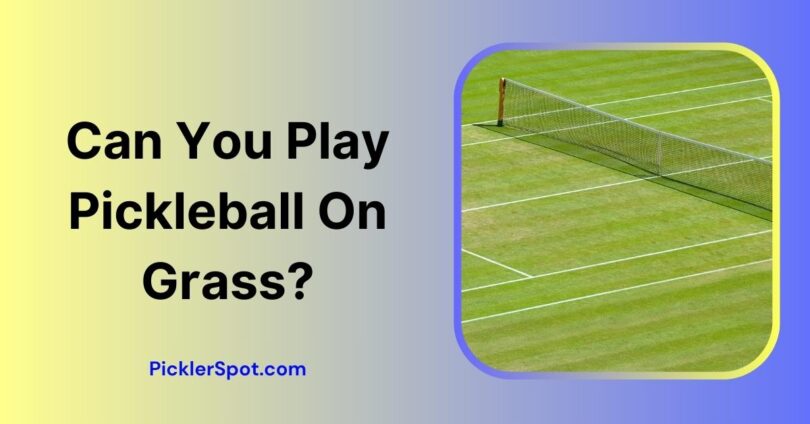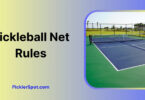Being a Pickleball enthusiast, I love experimenting with various techniques and play styles on the court on a regular basis.
Usually, these experiments happen to correspond around queries asked by my peers, friends, and family, most of which are then posted by me in the form of an elaborate guide so that everyone reading it can benefit from it.
This article is no exception as well since the other day I happened to set up my own Pickleball court in the back of my yard which has a little bit of vegetation and flora, which in fact posed quite a bit of a challenge that I will be describing in this brief guide revolving around the subject “Can You Play Pickleball On Grass” and even throw in tips on how to overcome any hurdle along the way.
Challenges You May Have To Face
In theory, Pickleball can be played almost anywhere as long as you meet the official court dimensions of 44 feet in length and 20 feet in width, however, before you proceed, there are things you need to keep in mind such as,
1. Horrendous Bounce Effects
Vegetation is grown on a clay or muddy surface for reasons that are pretty much obvious, meanwhile, Pickleball is supposed to be played on hard concrete or asphalt court and since clay has a higher tendency to absorb shock waves, no matter how hard you hit, your ball will always land low or won’t even bounce properly at all.
This will ruin the dynamics of the sport and shots like lob or Dink would feel next to impossible, so as long as you are fine playing the sport in an extremely weird setting and disregarding the possibility of pulling strategies and variation, your Experience would be seamless.
2. Possible Hazards
Grass tends to accumulate dew and can be extremely damp even if sunlight shines on it, especially early in the morning. This makes it quite dangerous, so if you aren’t watching your step, it’s highly likely that you are going to end up facing trouble sooner than you can imagine.
To top it off, mud and clay also have small pebbles in them which can be sharp or cause instability in the surface, making your maneuvering around the court considerably harder than you could imagine.
On the other hand, mudflat surfaces where the sun shines also have algae growth on them so it’s highly likely that it’s going to be extremely slippery even if you wear shoes with enhanced grip.
3. Probability Of Pests
Dense flora even if it’s considerably lower than usual in variety is a natural habitat of pests and reptiles such as salamanders, snakes, bugs, etc. If you aren’t cautious you are either going to hurt those creatures or yourself, so one or another its best advised that you carry out your session in your backyard when you have deemed it safe from any possible fauna.
The probability of such fauna increases tenfold if you are playing in the evening or in hot conditions where it’s highly likely that you are going to face such a fiasco.
4. Uneven Surface
Your backyard might seem like the most ideal place to kickstart your mini Pickleball career, however, it may drastically suffer from level-related issues since the topmost layer of Earth’s crust is primarily made from a homogeneous mixture of soil, clay, sand, and gravel which likely suffers from erosion, weathering, and human-based activity.
Such a loose and unconsolidated organic mixture of particles as a substrate of plants such as grass highly suffers from rough or patchy areas making it harder to land a ball without its trajectory being manipulated.
How Do You Play On Grass then?
Well if you do incline on playing after acknowledging all the possible hazards and hurdles beforehand, here is how you can play on grass,
1. Use A Specialized Ball
Unlike traditional balls which are made from synthetic plastic with hollow structures with around 20-40 holes, these balls have a rubberized coating with an additional felt material applied on their surface.
This enhances their ability to bounce and have better response time as compared to traditional Ball which may suffer from bounce-related issues on a mud.
Keep in mind that these special types of balls might be unnecessarily expensive and maybe even harder to hit. On the flip side, they may only be used for recreational purposes.
2. Wear Proper Shoes
Just because you are playing Pickleball in casual settings doesn’t mean you won’t have to follow proper guidelines and wear shoes with an abrasive grip underneath as the surface is likely to be slippery and may have sharp pebbles underneath.
It will also help you maneuver better on the court with much mobility as compared to playing barefoot altogether.
3. Mow Your Yard
It goes without saying that playing on grass can be an absolute nightmare and in order to make things much more manageable and gain traction it is wise that you trim the grass to a considerable amount, so that there is likely a chance that it would cause obstruction in your mobility.
It would also drastically reduce the chances of pests and other fauna growing around the grass, so keeping your grass trimmed not only makes it look nicer but you won’t have to worry about running into any pest-related nightmares.
4. Use Non-Toxic Paint
Your Pickleball adventures in your backyard would be temporary, so it’s pretty apparent that you don’t want to introduce toxic chemicals and paint that will ruin or harm the plants in the long run.
If you are planning to use paint to cover the boundaries and create multiple zones, make sure you use paint that is free from toxic chemicals.
Advantages Of Playing Pickleball On Grass
Now you would be pondering, after all the endeavors and potential hazards, is playing Pickleball on grass actually worth it? Well, to some extent, yes, here is how.
1. Cooler Environment
Clay and soil surface is considerably cooler than concrete and asphalt material has higher thermal mass and absorbs heat to a great degree.
Lower temperature means you are less likely to become dehydrated or suffer from heat stroke even when playing under direct sunlight. Having flora-like grass around further takes the temperature down a notch, so, in other words, your feet would stay comfortable even after a strenuous routine.
2. Cheaper Approach
One of the biggest advantages of playing in such a place is that you don’t have to invest in creating your private pickleball courts which certainly costs an arm and a limb.
In fact, you could start right away without suffering from any form of downtime as long as you have hung the net and covered all the boundaries with non-toxic and eco-friendly paint.
3. Higher Thrill Output
As ridiculous as it might sound, playing on such an uneven surface with poor bounce frequency might be a thrilling experience for those who simply want to embark on a challenge because you will have a rough time spinning the ball or even executing a proper strategy altogether.
So in other words, when life gives you lemons, make lemonade and have the best time of your life with your buddies.
Can You Play Pickleball on Grass? – Conclusion
Yes, you can certainly play Pickleball on a surface area with some grass on it, however, if the vegetation is too dense to cause unevenness, it might be time for you to mow down some chunks of flora so that you can easily eliminate any obstruction during maneuvering around your “DIY” court.
Nevertheless, I would highly advise you to set up a private court on a concrete surface, as you wouldn’t have to worry about the bounce frequency of the ball getting dampened or any other form of hazard in the court.
That being said, feel free to comment below if you have other doubts or confusion regarding this topic “Can you play pickleball on grass”, i would be much obliged to sort you out.
Good Luck 🤞 .









